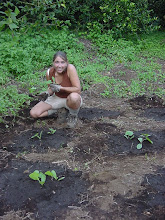 The ripeness, and ultimately the flavor, is determined by the color of the coffee's fruit, the cherry. Ideally you want to harvest only the reddest cherries, leaving the green ones more time to mature. This usually means harvesting more than once during the season, as the fruit does not all ripen at the same time.
The ripeness, and ultimately the flavor, is determined by the color of the coffee's fruit, the cherry. Ideally you want to harvest only the reddest cherries, leaving the green ones more time to mature. This usually means harvesting more than once during the season, as the fruit does not all ripen at the same time.As the veggies and fruits are my gardening project, I have had little to do with coffee farming. But this past year I did enjoy a dark rich blend derived from our very own local harvest for about six months, when our "year supply" ran out. Since then, I've had my eye on the coffee plants, keeping tabs on the growing green fruits. I have been excited to get in there hands-on to be a part of the process. Luckily for me, these ladies are patient and friendly teachers:
 Traveling from farm to farm during coffee season, November through January, Marta and her family pick the cash crop for 8 to 10 hours a day, earning their wages based on pounds picked per day.
Traveling from farm to farm during coffee season, November through January, Marta and her family pick the cash crop for 8 to 10 hours a day, earning their wages based on pounds picked per day. With a wide basket strapped around my waist, I accompanied Marta in the coffee field. The women chatted over the rows, invisible to each other but for rustling amongst the branches and occasional singing or humming. I struggled to keep up, scanning the bushes for red and clumsily yanking the ripe cherries into my basket. Within an hour Marta's basket was brimming with the multi-colored fruit, mine like so:
With a wide basket strapped around my waist, I accompanied Marta in the coffee field. The women chatted over the rows, invisible to each other but for rustling amongst the branches and occasional singing or humming. I struggled to keep up, scanning the bushes for red and clumsily yanking the ripe cherries into my basket. Within an hour Marta's basket was brimming with the multi-colored fruit, mine like so: We sell the majority of our coffee wet, meaning the unprocessed raw cherries, to a local buyer. By next year we plan to invest in larger scale processing equipment; currently the farm has only manual-operated machinery, which we used to process my contribution to the harvest. Our de-pulper is a charming antique device that separates the fruit skin from the seed of the coffee.
We sell the majority of our coffee wet, meaning the unprocessed raw cherries, to a local buyer. By next year we plan to invest in larger scale processing equipment; currently the farm has only manual-operated machinery, which we used to process my contribution to the harvest. Our de-pulper is a charming antique device that separates the fruit skin from the seed of the coffee.The seeds retain a clear, slimy layer that aids in an overnight fermentation. The following day they are rinsed thoroughly and spread out on a screen to sun dry.
 From here, there is yet another hulling procedure to remove a papery layer of skin; then roasting (locally this is done over an open fire); finally, grinding and brewing!
From here, there is yet another hulling procedure to remove a papery layer of skin; then roasting (locally this is done over an open fire); finally, grinding and brewing!While these seeds dry, I await the call for the next harvest. Hopefully my picking fingers will gain speed and agility so that I can pull in enough for the coming year ;)






3 comentarios:
Very cool. I'm impressed!
What an interesting blog! I've enjoyed the posts I've read up till now. Another enhancement for Blotanical - a garden blog from Central America. Welcome! Barbara
good information.... Luwak coffee is best...frienship greetings from indonesia
Publicar un comentario